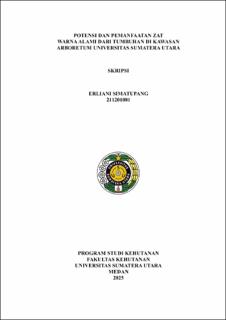Potensi dan Pemanfaatan Zat Warna Alami dari Tumbuhan di Kawasan Arboretum Universitas Sumatera Utara
Potential and Utilization of Natural Dyes from Plants in the Arboretum of Universitas Sumatera Utara

Date
2025Author
Simatupang, Erliani
Advisor(s)
Nuryawan, Arif
Risnasari, Iwan
Metadata
Show full item recordAbstract
In recent years, environmental issues have driven the search for more
environmentally friendly alternative materials in various industries. One of the
efforts utilized is the use of natural dyes derived from plants. The Arboretum of
Universitas Sumatera Utara (USU), which is a biodiversity conservation area, has
great potential as a source of natural dyes. Some plant parts such as leaves, bark,
flowers, and fruits are known to contain natural coloring compounds such as
anthocyanins, flavonoids, tannins, and carotenoids that can be used as food,
cosmetic, and textile dyes. This research was conducted using the census method,
by inventory, namely by analyzing all plant species in the Arboretum of USU area.
The results showed that there were 47 tree species and 28 families found in the
Arboretum of USU, with the Moraceae family being the most dominant. The tree
species with the highest number of individuals was Pulai (Alstonia scholaris), with
541 individuals or 11.83% of the total population. There were 60 species of
understory plants, with the most abundant being the sword fern (Nephrolepis
biserrata), numbering 11,812 or 17.05% of the total individuals. There are 33
species of understory plants and 21 species of trees that have the potential as
natural dyes, while the leaves that have the potential as pattern for ecoprint are 16
species.
Collections
- Undergraduate Theses [2162]
